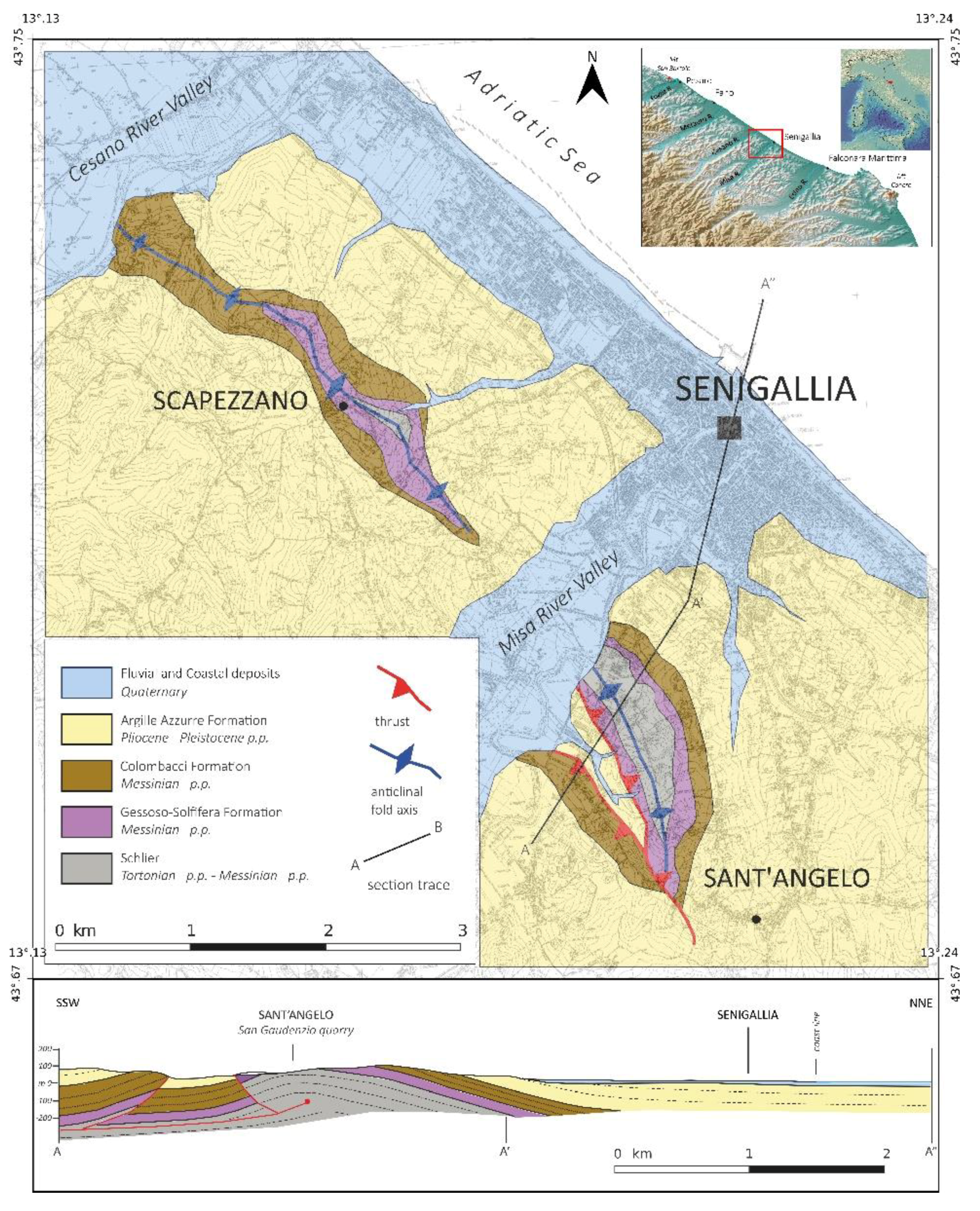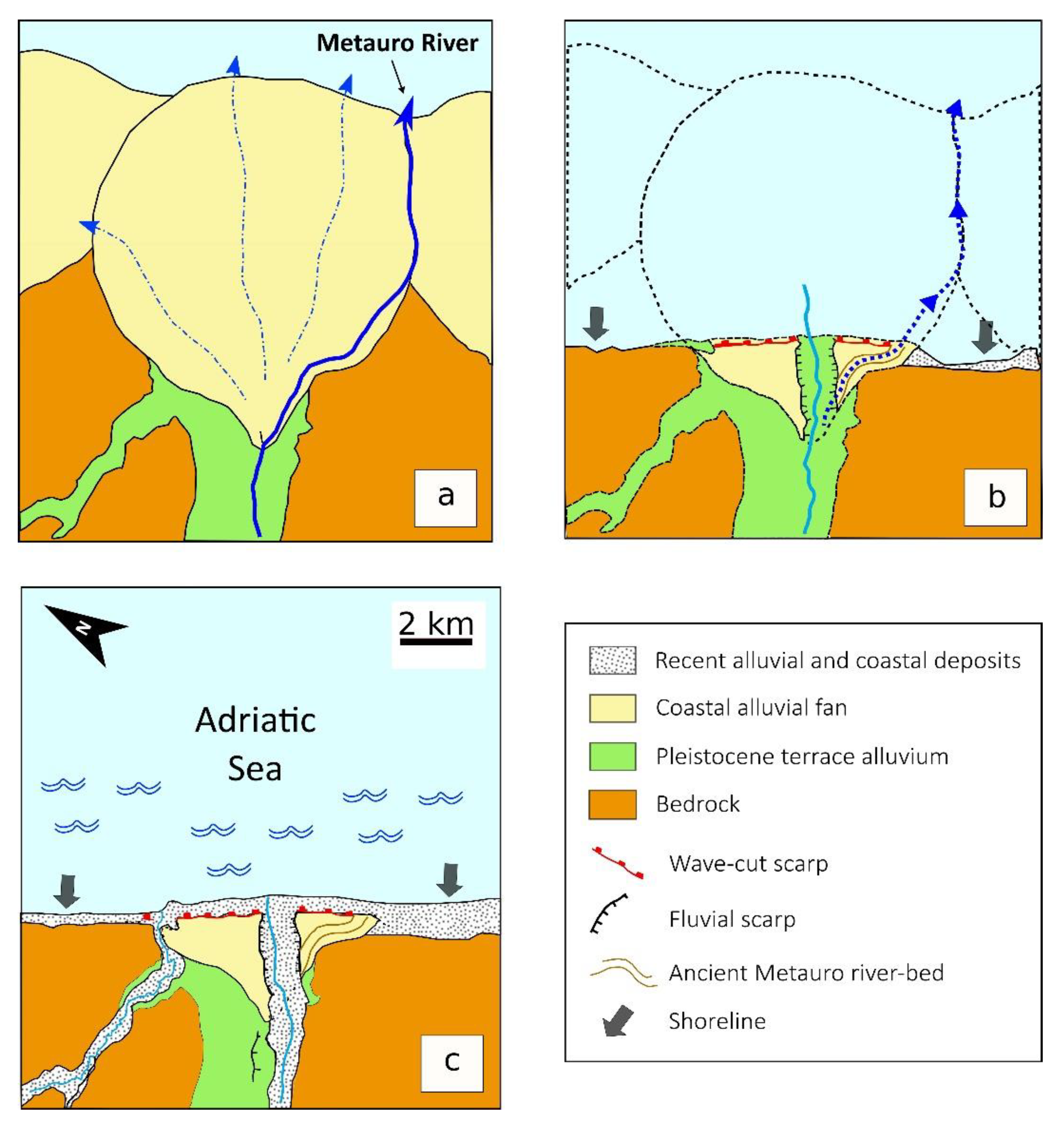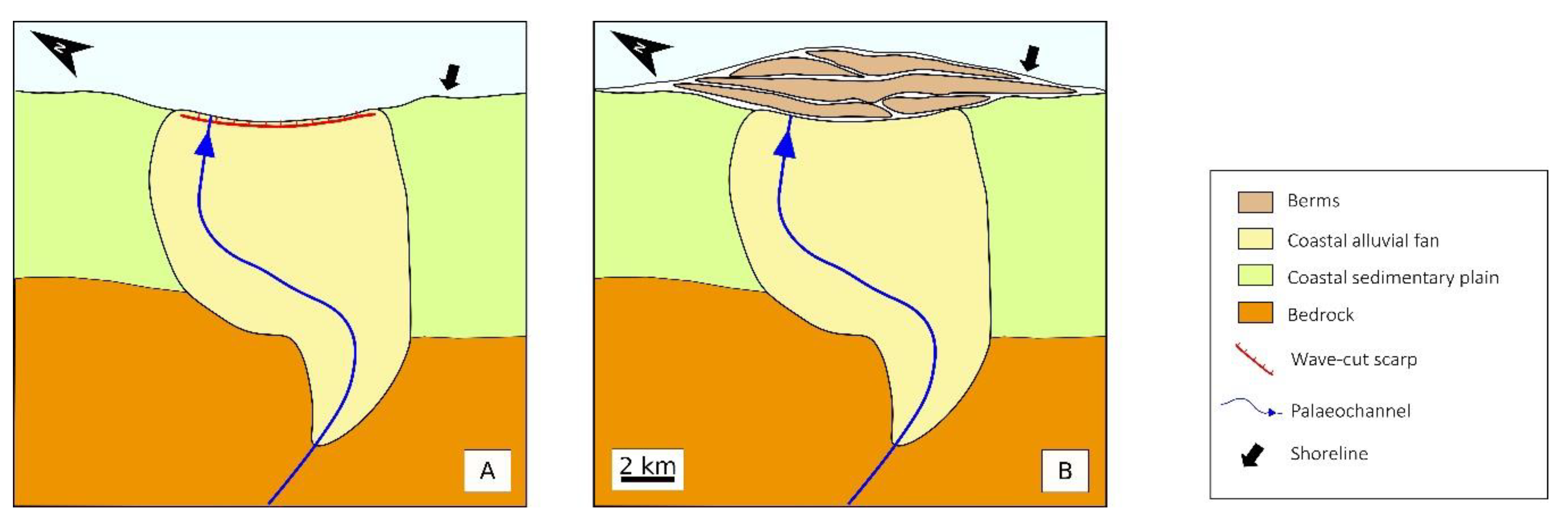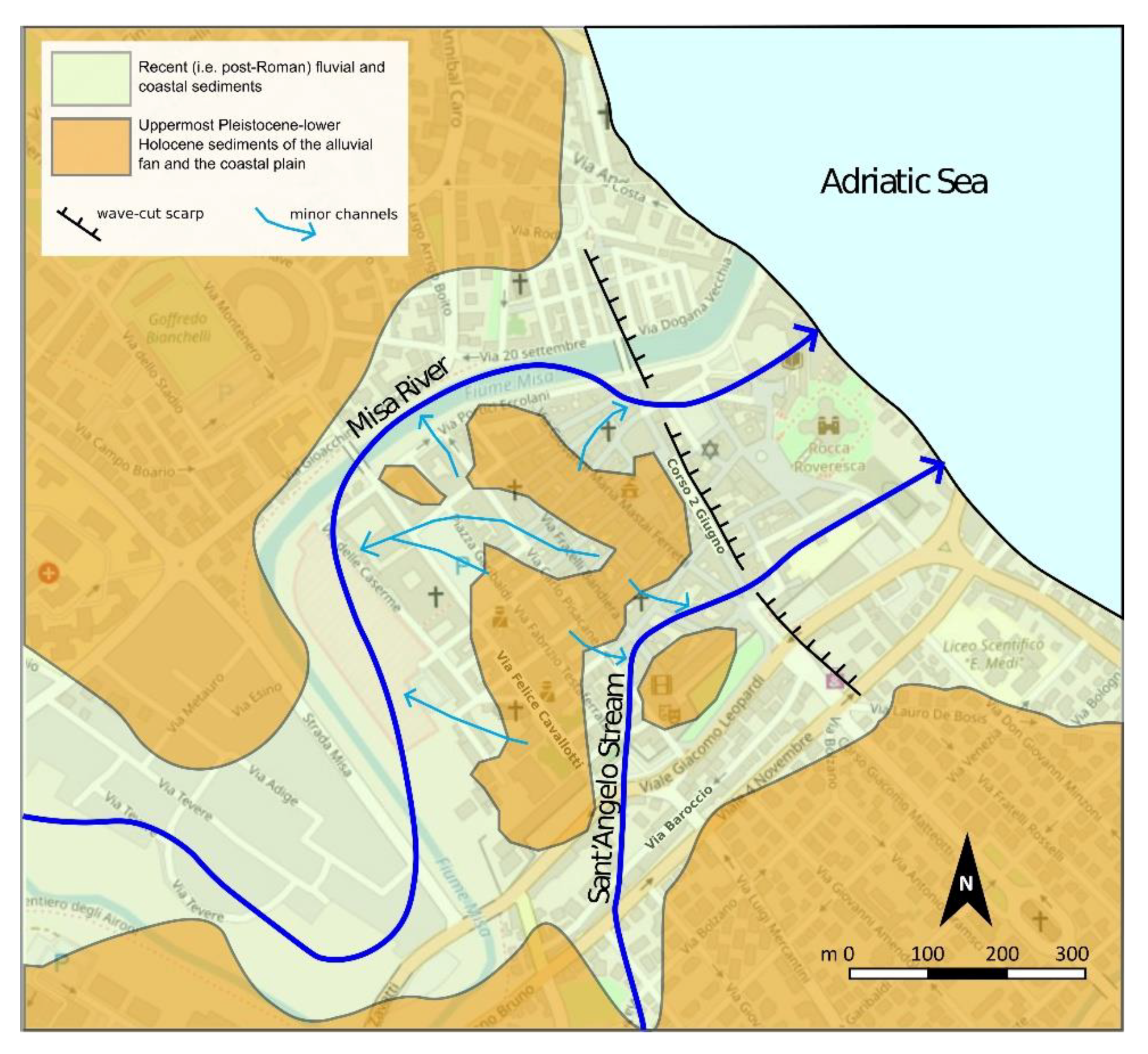Geomorphological Evolution of the Sena Gallica Site in the Morpho-Evolutive Quaternary Context of the Northern-Marche Coastal Sector (Italy)
Abstract
1. Introduction
2. Study Methods and Materials
- (1)
- The subsurface geology data of Senigallia were sourced mainly from the direct field work mapping the surrounding areas, taking also into account the CARG (Cartografia Geologica Regionale; Geological Cartography of Italy) maps (scale of 1:50,000) and Marche region geological maps (scale of 1:10,000). Most of those surveys were supported by digital tools (tablet pc and GPS receivers) with mobile GIS (QGIS (Quantum Geographic Information System) freeware software with ad-hoc developed plug-ins) [7].
- (2)
- The geomorphological settings of the surrounding sectors where the Senigallia area is framed is the result of previous studies (see further chapters for bibliography). In particular, the alluvial fans reconstructions and the shoreline variations were based on field work, e.g., [4], and aerial photographs’ analysis (starting from the G.A.I. (Gruppo Aeronautico Italiano) historical photos of the IGMI-Istituto Geografico Militare Italiano, dating back to 1954–1956 up to recent images), historic cartography (see further chapters), fieldwork, probes radiocarbon dating, and geostatistical analysis [11].
- (3)
- The geophysical prospectings represent important contributions to the dataset of this work. Resistivity, seismic, ground penetrating radar, and electromagnetic techniques were exploited to capture information in the urban area where non-invasive methods were required. The interpretations of the geophysical data set were validated with a number of probes. The geognostic dataset of 86 mechanical continuous probing and 30 standard penetrations tests (from the database of the Senigallia municipality) were integrated with 21 hand probings (carried out by archaeologists) in some sectors of greater interest or where data were missing [17].
- (4)
- The archaeological excavations and the analysis carried out by archaeologists provided new timing data and sedimentological information which improved and detailed the interpretation of the evolution mainly of the Senigallia area.
3. Geomorphological Evolution
3.1. Geomorphology and Holocene Evolution of the Coastal Plain
- The slope is much older and probably polyphasic. The geometry of the Middle Pliocene terraces suggests that the shoreline has approached it during at least two other previous interglacial episodes [28].
- The “Flandrian shore“ cannot coincide with the slope along all of its extension. In fact, the coastal Metauro and Cesano alluvial fans (here described at point 3.1.1), which are still well preserved in their apical portions, “protect“ rather extensive slope segments and/or “lean“ on them by covering them.
3.1.1. The Coastal Alluvial Fans and their Role in the Evolution of the Holocenic Coastal Plains
3.1.2. The Post-Roman Plain
3.2. The Site in Roman Times and the Main Later Alterations
3.2.1. End of the Pleistocene to the Beginning of the Holocene
3.2.2. First Half of the Holocene
3.2.3. From the Second Half of the Holocene to the Roman Age
3.2.4. Roman Age
3.2.5. Post-Roman age
4. Concluding Remarks
- The settlement choice of Roman villages alongside the North-Marche coast was influenced by the geomorphology of the area. All the main Northern Marche coastal towns are located at the mouth or near important waterways. In particular, Sena Gallica is located at the mouth of the Misa river, taking advantage of a slightly risen area, which was protected by the sea, watercourses and coastal ponds.
- The position of shorelines during the highstand events. In the coastal sector where Sena Gallica rises, the shoreline position remained almost unchanged during late Quaternary highstand events. On the contrary, the contiguous coasts both to the North (Fano-Gabicce sector) and to the South (Falconara-Ancona sector) were characterized by significant regressions of the highstand shorelines. In this context, the cliffs (seaward prominences of Colle Ardizio-San Bartolo and of Falconara-Ancona-Monte Conero) and the middle sector (the gentle bay-shaped sector between Fano and the mouth of the Esino river) are characterized by coastal planes, which are variously articulated and have different widths and complexities, can be explained.
- The presence of apical relics of late Pleistocene–Holocene coastal fans and the creation of the berms. At the mouth of the main rivers, the building and dismantling of fans led to the formation of small but important coastal cliffs and the presence of gently elevated sectors, such as the one on which the town arose. In the specific case of Sena Gallica, minor oscillations of the shoreline around the position achieved with the maximum Holocene ingression (marked by the “outfall cliff“) may have contributed to the high point corresponding to the apex of Misa fan extending seawards through the creation of berms.
- The construction of the coastal plain. Starting from the 16th century, the sedimentation moved the shoreline definitively away from the original settlement, causing partial drowning under the recent fluvial and coastal sediments of the apical portion of the coastal fan of the Misa river.
- Presence of the modest channels that dissected the surface of the fan itself. This feature is related to the gully dissection of the fan-apex, which after the maximum marine ingression, developed a minor hydrographic network.
- Strong interconnections and mutual influences between natural processes and human activity. The important modifications and remodeling of the territory are related to the construction of riverbanks and containment walls, the excavation of artificial channels, and/or the rectification and deviation of minor channels and of the same Misa river.
- Exposition of a large area of the city to floods during the post-Roman age (between the 16th and 18th centuries). The dismantling of the Roman walls exposed a large area of the town to repeated floods, determining an elevation of the local soil to its current topography.
Author Contributions
Funding
Acknowledgments
Conflicts of Interest
References
- Bandelli, G. La colonizzazione medio-adriatica fino alla seconda guerra punica: Questioni preliminari (Middle-Adriatic colonization until the Second Punic War: Preliminary issues). In La battaglia del Metauro. Tradizione e Studi (The Battle of Metauro. Tradition and Studies); Luni, M., Ed.; Editrice Quattro Venti: Urbino, Italy, 2002; Volume 11, pp. 21–53. ISBN 88-392-0636-1. [Google Scholar]
- Lepore, G.; Ciuccarelli, M.R.; Assenti, G.; Belfiori, F.; Boschi, F.; Carra, M.; Casci Ceccacci, T.; De Donatis, M.; Maini, E.; Savelli, D.; et al. Progetto “Archeologia urbana a Senigallia” I: Le ricerche di via Cavallotti. J. Fasti Online 2012, 248, 1–19. [Google Scholar]
- Lepore, G. L’origine della colonia di Sena Gallica (The origin of the colony of sena Gallica). In Proceedings of the Epigrafia e Archeologia Romana Nel Territorio Marchigiano (Epigraphy and Roman Archaeology in the Marche Territory), Macerata, Italy, 22–23 April 2013; Tored, S.R.L., Ed.; Volume 13, pp. 297–322. [Google Scholar]
- ISPRA (Istituto Superiore per la Protezione e la Ricerca Ambientale) CARG Project—Geologic and Geothematic Cartography—English. Available online: http://www.isprambiente.gov.it/en/projects/soil-and-territory/carg-project-geologic-and-geothematic-cartography?set_language=en (accessed on 28 May 2019).
- Guerrera, F.; Tramontana, M. Note Illustrative Della Carta Geologica d’Italia Alla Scala 1:50.000, Foglio 281 Senigallia; Note Illustrative Della Carta Geologica d’Italia alla scala 1:50.000; ISPRA—Istituto Superiore per la Protezione e la Ricerca Ambientale: Rome, Italy, 2011.
- Elmi, C.; Fanucci, F.; Nesci, O.; Beer, G.; Pignocchi, A. Evoluzione olocenica della linea di riva adriatica dal F. Reno al F. Potenza (Italia centrale). Il Quat. 1994, 7, 305–310. [Google Scholar]
- Bracaloni, A. Geoarcheologia a Senigallia: Un Rilevamento Geologico Per La Ricerca Dei Materiali Lapidei Delle Mura Romane; Università degli Studi di Urbino Carlo Bo: Urbino, Italy, 2013. [Google Scholar]
- Ricci Lucchi, F. The Oligocene to Recent foreland basins of the Northern Apennines. Spec. Publs. Int. Ass. Sediment. 1986, 8, 105–139. [Google Scholar]
- Antonioli, F.; Ferranti, L.; Fontana, A.; Amorosi, A.; Bondesan, A.; Braitenberg, C.; Dutton, A.; Fontolan, G.; Furlani, S.; Lambeck, K.; et al. Holocene relative sea-level changes and vertical movements along the Italian and Istrian coastlines. Quat. Int. 2009, 206, 102–133. [Google Scholar] [CrossRef]
- Calderoni, G.; Della Seta, M.; Fredi, P.; Lupia Palmieri, E.; Nesci, O.; Savelli, D.; Troiani, F. Late Quaternary geomorphological evolution of the Adriatic coast reach encompassing the Metauro, Cesano and Misa river mouths (Northern Marche, Italy). GeoActa 2010, 3, 109–124. [Google Scholar]
- Troiani, F.; Della Seta, M. Geomorphological response of fluvial and coastal terraces to Quaternary tectonics and climate as revealed by geostatistical topographic analysis. Earth Surf. Proc. Land. 2011, 36, 1193–1208. [Google Scholar] [CrossRef]
- Trincardi, F.; Campiani, E.; Correggiari, A.; Foglini, F.; Maselli, V.; Remia, A. Bathymetry of the Adriatic Sea: The legacy of the last eustatic cycle and the impact of modern sediment dispersal. J. Maps 2014, 10, 151–158. [Google Scholar] [CrossRef]
- Trincardi, F.; Correggiari, A.; Roveri, M. Late Quaternary transgressive erosion and deposition in a modern epicontinental shelf: The Adriatic semienclosed basin. Geo-Mar. Lett. 1994, 14, 41–51. [Google Scholar] [CrossRef]
- Coltorti, M. Modificazioni morfologiche oloceniche nelle piane alluvionali marchigiane: Alcuni esempi nei fiumi Misa, Cesano e Musone. Geogr. Fis. Dinam. Quat. 1991, 14, 73–86. [Google Scholar]
- Dall’Aglio, P.L.; De Donatis, M.; Franceschelli, C.; Guerra, C.; Guerra, V.; Nesci, O.; Piacentini, D.; Savelli, D. Geomorphological and anthropic control of the development of some Adriatic historical towns (Italy) since the Roman age. Quaest. Geogr. 2017, 36, 111–123. [Google Scholar] [CrossRef]
- De Donatis, M.; Lepore, G.; Susini, S.; Silani, M.; Boschi, F.; Savelli, D. Sistemi informativi geografici e modellazione tridimensionale per la Geo-archeologia a Senigallia: Nuove scoperte e nuove ipotesi. Rend. Online Soc. Geol. Ital. 2012, 19, 16–19. [Google Scholar]
- Silani, M.; De Donatis, M.; Savelli, D.; Boschi, F.; Lepore, G.; Susini, S. Geo-archaeology of the Roman palaeosurface of Sena Gallica (Senigallia, Italy). J. Maps. 2016, 12, 1206–1211. [Google Scholar] [CrossRef]
- Curzi, P.; Tonnarelli, D. I litorali marchigiani. In L’ambiente Fisico delle Marche. Regione Marche; Giunta Regionale, Assessorato Urbanistica e Ambiente: Firenze, Italia, 1991; pp. 213–226. [Google Scholar]
- Coltorti, M. Human impact in the Holocene fluvial and coastal evolution of the Marche region, Central Italy. Catena 1997, 30, 311–335. [Google Scholar] [CrossRef]
- Elmi, C.; Nesci, O.; Savelli, D.; Forti, P. La risposta dei processi geomorfologici alle variazioni ambientali nella Pianura Padana e Veneto-friulana, nelle pianure minori e sulle coste nord e centro-adriatiche. In Risposta Dei Processi Geomorfologici Alle Variazioni Ambientali; Biancotti, A., Motta, M., Eds.; Glauco Brigati: Genova, Italy, 2003; pp. 225–259. [Google Scholar]
- Bosellini, A. Outline of the geology of Italy. In Landscapes and Landforms of Italy; Soldati, M., Marchetti, M., Eds.; World Geomorphological Landscapes; Springer International Publishing: New York, NY, USA, 2017; pp. 21–27. ISBN 978-3-319-26192-8. [Google Scholar]
- De Marchi, L. Variazioni del livello dell’Adriatico in corrispondenza colle espansioni glaciali. Atti Accad. Sci. Veneto-Trentino-Istriana 1922, 12, 1–15. [Google Scholar]
- Siddall, M.; Rohling, E.J.; Almogi-Labin, A.; Hemleben, C.; Meischner, D.; Schmelzer, I.; Smeed, D.A. Sea-level fluctuations during the last glacial cycle. Nature 2003, 423, 853–858. [Google Scholar] [CrossRef] [PubMed]
- Van Straaten, L.M.J.U. Sedimentation in the northwestern part of the Adriatic Sea. In Proceedings of the 17th Symposium Colston Research Society, Bristol, UK, 5–9 April 1965; Bristol University: Bristol, UK, 1965; pp. 143–160. [Google Scholar]
- Ferretti, M.; Moretti, E.; Savelli, D.; Stefanon, A.; Tramontana, M.; Wezel, F.C. Late Quaternary alluvial sequences in the north-western Adriatic Sea from Uniboom profiles. Boll. Oceanol. Teor. Appl. 1986, 4, 63–72. [Google Scholar]
- Amorosi, A.; Maselli, V.; Trincardi, F. Onshore to offshore anatomy of a late Quaternary source-to-sink system (Po Plain-Adriatic Sea, Italy). Earth Sci. Rev. 2016, 153, 212–237. [Google Scholar] [CrossRef]
- Lambeck, K.; Antonioli, F.; Purcell, A.; Silenzi, S. Sea-level change along the Italian coast for the past 10,000yr. Quat. Sci. Rev. 2004, 23, 1567–1598. [Google Scholar] [CrossRef]
- Nesci, O.; Savelli, D.; Tramontana, M.; Troiani, F. Geomorphologic indicators of late Quaternary river mouth position: A key to morphoevolutive reconstructions in the Northern Marchean coastal areas. In Proceedings of the II Workshop Annuale VECTOR, Rome, Italy, 25–26 February 2009. [Google Scholar]
- Ferranti, L.; Antonioli, F.; Mauz, B.; Amorosi, A.; Dai Pra, G.; Mastronuzzi, G.; Monaco, C.; Orrù, P.; Pappalardo, M.; Radtke, U.; et al. Markers of the last interglacial sea-level high stand along the coast of Italy: Tectonic implications. Quat. Int. 2006, 145–146, 30–54. [Google Scholar] [CrossRef]
- Colantoni, P.; Mencucci, D.; Nesci, O. Coastal processes and cliff recession between Gabicce and Pesaro (northern Adriatic Sea): A case history. Geomorphology 2004, 62, 257–268. [Google Scholar] [CrossRef]
- Vannoli, P.; Basili, R.; Valensise, G. New geomorphic evidence for anticlinal growth driven by blind-thrust faulting along the northern Marche coastal belt (central Italy). J. Seismol. 2004, 8, 297–312. [Google Scholar] [CrossRef]
- Nesci, O.; Savelli, D.; Troiani, F. Types and development of stream terraces in the Marche Apennines (central Italy): A review and remarks on recent appraisals. Géomorphologie 2012, 18, 215–238. [Google Scholar] [CrossRef]
- Cattaneo, A.; Trincardi, F. The late-quaternary transgressive record in the Adriatic Epicontinental Sea: Basin widening and facies partioning. In Isolated Shallow Marine Sand Bodies: Sequence Stratigraphyc Analysis and Sedimentologic Interpretation; SEPM Special Publication: Broken Arrow, OK, USA, 1999; Volume 64, pp. 127–146. [Google Scholar]
- Cattaneo, A.; Trincardi, F.; Asioli, A.; Correggiari, A. The western Adriatic shelf clinoform: Energy-limited bottomset. Cont. Shelf Res. 2007, 27, 506–525. [Google Scholar] [CrossRef]
- Fleming, K.; Johnston, P.; Zwartz, D.; Yokoyama, Y.; Lambeck, K.; Chappell, J. Refining the eustatic sea-level curve since the Last Glacial Maximum using far- and intermediate-field sites. Earth Planet. Sci. Lett. 1998, 163, 327–342. [Google Scholar] [CrossRef]
- Pirazzoli, P.A. A review of possible eustatic, isostatic and tectonic contributions in eight late-Holocene relative sea-level histories from the Mediterranean area. Quat. Sci. Rev. 2005, 24, 1989–2001. [Google Scholar] [CrossRef]
- Nesci, O.; Savelli, D.; Troiani, F. Evoluzione Tardo-Quaternaria Dell’area di Foce del Metauro (Marche Settentrionali); Autorità di Bacino della Basilicata: Maratea, Italy, 2008; Volume 9, pp. 443–451. [Google Scholar]
- Posarnentier, H.W.; Allen, G.P. Siliciclastic Sequence Stratigraphy—Concepts and Applications. In Sedimentology and Paleontology; SEPM Concepts; SEPM Society for Sedimentary Geology: Tulsa, OK, USA, 1999; Volume 7, ISBN 978-1-56576-319-7. [Google Scholar]
- Wegmann, K.W.; Pazzaglia, F.J. Late Quaternary fluvial terraces of the Romagna and Marche Apennines, Italy: Climatic, lithologic, and tectonic controls on terrace genesis in an active orogen. Quat. Sci. Rev. 2009, 28, 137–165. [Google Scholar] [CrossRef]
- Baldelli, G.; Bucci, C.; Calderoni, G.; Colantoni, P.; Donatelli, U.; Longhini, M.; Nesci, O.; Savelli, D.; Tramontana, M.; Troiani, F. Further insights on the recent coastal evolution at Fano area (Northern Marche) resulting from a new drilling. In Proceedings of the II workshop annuale VECTOR, Rome, Italy, 25–26 February 2009; p. 73. [Google Scholar]
- Dall’Aglio, P.L. La viabilità di età romana. In Archeologia delle valli marchigiane Misa, Nevola e Cesano; Dall’Aglio, P.L., De Maria, S., Mariotti, A., Eds.; Mondadori Electa: Milano, Italia, 1991; pp. 12–23. [Google Scholar]
- Elmi, C.; Colantoni, P.; Gabbianelli, G.; Nesci, O. Holocene shorelines along the central Adriatic coast (Italy). GeoActa 2001, 1, 27–36. [Google Scholar]
- Luni, M. La cinta muraria di Fanum Fortunae (Fano). In Fano Romana; Milesi, F., Ed.; Editrice Fortuna: Fano, Italy, 1992; pp. 89–138. [Google Scholar]
- Dall’Aglio, P.L.; Nesci, O. Storia e Geografia Fisica del territorio costiero tra le foci dei fiumi Metauro e Foglia (History and physical geography of the coastal area between the Metauro and Foglia river mouths). In L’indagine e la rima. Scritti per Lorenzo Braccesi (The Investigation and the Rhyme: Written for Lorenzo Braccesi); Debiasi, A., Bassani, M., Pastorio, E., Eds.; L’Erma di Bretschneider: Rome, Italia, 2013; pp. 439–451. ISBN 978-88-913-0290-8. [Google Scholar]
- Lepore, G.; Belfiori, F.; Boschi, F.; Casci Ceccacci, T.; Silani, M. Nuovi dati sull’origine di Sena Gallica. Ocnus 2012, 20, 155–180. [Google Scholar]
- Veggiani, A. Le greppe del mare. Parametro 1982, 110, 22–23. [Google Scholar]
- Holzhauser, H.; Magny, M.; Zumbuühl, H.J. Glacier and lake-level variations in west-central Europe over the last 3500 years. Holocene 2005, 15, 789–801. [Google Scholar] [CrossRef]
- Piva, A.; Asioli, A.; Trincardi, F.; Schneider, R.R.; Vigliotti, L. Late-holocene climate variability in the Adriatic Sea (Central Mediterranean). Holocene 2008, 18, 153–167. [Google Scholar] [CrossRef]
- Dramis, F.; Aringoli, D.; Bisci, C.; Cantalamessa, G.; Coltorti, M.; Farabollini, P.; Gentili, B.; Materazzi, M.; Nesci, O.; Pambianchi, G.; et al. La Costa delle Marche. In La Costa d’Italia; Ginesu, S., Ed.; Carlo Delfino Editore: Sassari, Italia, 2011; pp. 379–392. [Google Scholar]
- Savelli, D.; Troiani, F.; Cavitolo, P.; Nesci, O. Rock cliffs joining velvet beaches: The northern marche coast. In Landscapes and Landforms of Italy; Soldati, M., Marchetti, M., Eds.; World Geomorphological Landscapes; Springer International Publishing: New York, NY, USA, 2017; pp. 271–280. ISBN 978-3-319-26192-8. [Google Scholar]
- Lepore, G.; Mandolini, E.; Silani, M.; Belfiori, F.; Galazzi, F. Archeologia urbana a Senigallia III: I nuovi dati dall’area archeologica “La Fenice”. J. Fasti Online 2014, 308, 32. [Google Scholar]
- Lepore, G.; De Marinis, G.; Belfiori, F.; Boschi, F.; Silani, M. Progetto “archeologia urbana a Senigallia” II: Le ricerche di via Baroccio e di via Gherardi. J. Fasti Online 2012, 248, 30. [Google Scholar]
- De Donatis, M.; Susini, S.; Foi, M. Geology from real field to 3D modeling and Google Earth virtual environments: Methods and goals from the Apennines (Furlo Gorge, Italy). In Google Earth and Virtual Visualizations in Geoscience Education and Research; Whitmeyer, S.J., Bailey, J.E., De Paor, D.G., Ornduff, T., Eds.; Geological Society of America: Boulder, CO, USA, 2012; Volume 492, pp. 221–233. ISBN 978-0-8137-2492-8. [Google Scholar]
- Giarrizzo, A. Senigallia. Ricerche di geografia urbana. Boll. Soc. Geogr. Ital. 1963, 4, 444–496. [Google Scholar]
- Ortolani, M.; Alfieri, N. Sena Gallica. Rend. Acc. Lincei 1953, VIII, 152–180. [Google Scholar]




© 2019 by the authors. Licensee MDPI, Basel, Switzerland. This article is an open access article distributed under the terms and conditions of the Creative Commons Attribution (CC BY) license (http://creativecommons.org/licenses/by/4.0/).
Share and Cite
De Donatis, M.; Nesci, O.; Savelli, D.; Pappafico, G.F.; Susini, S. Geomorphological Evolution of the Sena Gallica Site in the Morpho-Evolutive Quaternary Context of the Northern-Marche Coastal Sector (Italy). Geosciences 2019, 9, 272. https://doi.org/10.3390/geosciences9060272
De Donatis M, Nesci O, Savelli D, Pappafico GF, Susini S. Geomorphological Evolution of the Sena Gallica Site in the Morpho-Evolutive Quaternary Context of the Northern-Marche Coastal Sector (Italy). Geosciences. 2019; 9(6):272. https://doi.org/10.3390/geosciences9060272
Chicago/Turabian StyleDe Donatis, Mauro, Olivia Nesci, Daniele Savelli, Giulio F. Pappafico, and Sara Susini. 2019. "Geomorphological Evolution of the Sena Gallica Site in the Morpho-Evolutive Quaternary Context of the Northern-Marche Coastal Sector (Italy)" Geosciences 9, no. 6: 272. https://doi.org/10.3390/geosciences9060272
APA StyleDe Donatis, M., Nesci, O., Savelli, D., Pappafico, G. F., & Susini, S. (2019). Geomorphological Evolution of the Sena Gallica Site in the Morpho-Evolutive Quaternary Context of the Northern-Marche Coastal Sector (Italy). Geosciences, 9(6), 272. https://doi.org/10.3390/geosciences9060272





